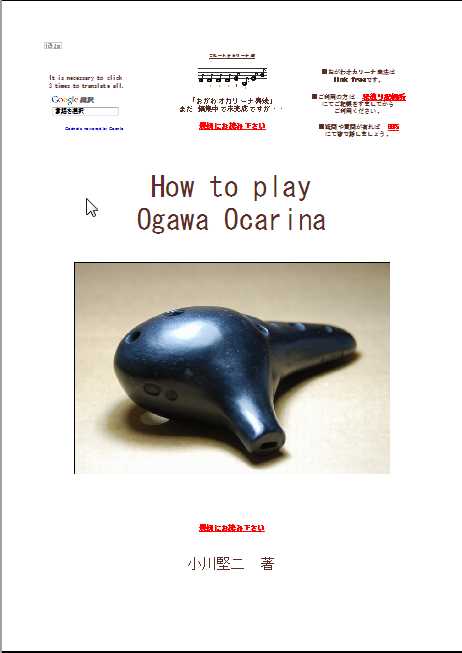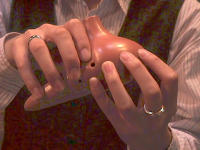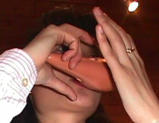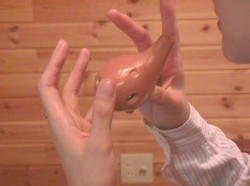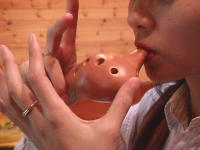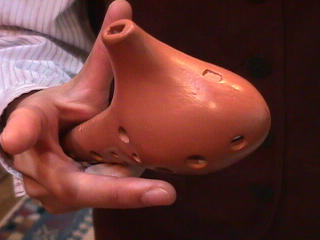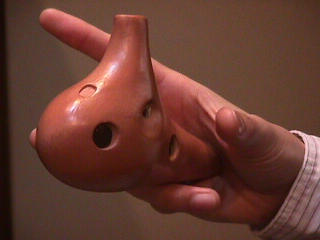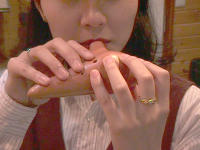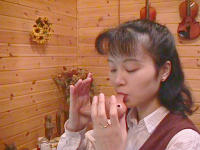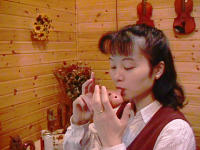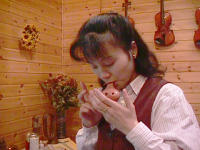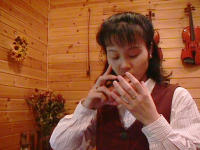"How to Hold an Ocarina of Kenji Ogawa"
(How to Hold an Ocarina)
Holding an ocarina is a very difficult thing although it is a simple, small, and adorable instrument. For this reason, there are some ocarinas that you can hang with a string from your neck. This prevents the instrument from breaking when it drops from your hands. However, if this really happens when you are performing, the music would be cut off anyway. For all musical instruments, both the way to hold them and the body position are very important. This doesn't mean you should only "look" like a professional.
There is a big difference between how to hold a flute and a Noukan (a Japanese flute for Nou performance). Their fingerings are also different. I think this difference corresponds to the fact that a flute is a rational instrument whereas a Noukan is a spiritual one.
How to hold an ocarina - it should be reasonable
Issues within the standard tone rangePhoto 1
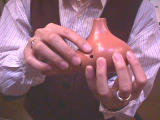
Photo 2
I'll talk about the angle of the right hand against the instrument. While a lot of people hold it like photo 1, I myself hold like photo 2. When you change the angle, the interval of the fingers will change. This suggests that you might have difficulty in matching your finger interval to the interval of your instrument's tone holes. Although the angle will be changed superficially when you play the high tones as I write below, this is the basic position.
The reason you don't hold like photo2 (amended on Feb/7/99)
If you hold the ocarina like photo 1, I assume your standing and body positions are not appropriate. It is not reasonable to play the ocarina with your body facing straight ahead as is just the same with the flute.
If you hold an ocarina with your body facing straight ahead, you will have to bend your right wrist. Trying to avoid this, you will hold the instrument like photo 1. If you play like this, you will not be able to stretch your fingers when you want to play low "Si" and "La", resulting in a failure to play those notes properly. In the worst case scenario, you might hurt your wrist or develop a stiff neck.
In order to solve this problem, your body should face 45 degrees to your right while the ocarina keeps facing straight ahead. Your shoulder line will face the same direction as your body. Still, your face should face straight ahead. If you do this, you'll find your right elbow, wrist, and fingers will be aligned. To summarize, your body should face 45 degree to your right while keeping your face straight ahead.
Drawbacks of the method where you put your thumbs near the tone holes instead of releasing completely from the holes when playing high tones.
There is a similar technique for playing the recorder. More people do this than you might suspect. Obviously, this is a problem in playing the ocarina. You can prove it easily by doing a simple experiment.
Let's give it a try.
Close your right forefinger to one of the finger holes when you're playing "So". (You will obtain the same result no matter which finger hole you use.) Now, what happened?
You found the pitch has become lower?
As you can presume from this, you had better avoid placing your thumbs beside the tone holes when you play high notes, because that would result in lowering the pitch. Your thumbs should be at least 5 mm away from the holes.A Good example (the thumbs are away from the tone holes.)

If you can't stop doing this, there are two alternatives. 1) adjust the tone holes or 2)Make the tone higher by adjusting your breath. If you make an ocarina yourself, you will find that the most difficult thing in making an ocarina is to make it possible to play the highest tones. Nothing would be easier than making an ocarina if it were not for the highest tone. Therefore, you should avoid lowering the pitch of high tones by placing your fingers or thumbs near the tone holes, because the producers of the instrument make such an effort in adjusting the pitches of those tones. If you want to adjust the pitch by changing your breath, how would you do it when you play a quick passage? You would need beyond-human breath control.
I have seen only a few people so far who do this, but there might be a lot more. Personally I'm not be able to do this. I assume those people have excellent balance. They make me worry when I watch them play, though. (But it's not my business....)
Some people hold the ocarina with their right little finger at the bottom side and their ring finger on the upper side of the instrument.
This method is introduced in many books, and a lot of professional players have adapted it.
There is nothing wrong with this technique, but I don't know the specific reasons why they hold it like this. It is interesting that the ocarinas made by those who take in this method have long right side ends. I find some instruments extraordinarily long although I don't usually notice. I personally would avoid making such ocarinas, because it would affect the sound and the finger holes.
My suggestions on holding the ocarina
Attention
This is my original way of having.
When you exhibit this method, please show clearly that it is "The method of Kenji Ogawa."
-----------------------It is a moral problem.
Here are the basics:
1) When you come to 'So' note, rotate your right wrist with the right thumb as a pivot to hold the right end of the instrument with right palm.2) When you come to a high 'Re' note, hold the left end of the instrument with your left thumb.
Please see the photos.
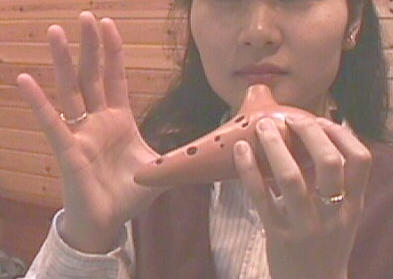
Note the right palm position.
Bend the ring and little fingers lightly.
=============================
Don't cover the holes with fingers.
There is a site which has carried the idea of my site without a credit.
You should know that it is not your idea.
You should just display link. I pray for you.
=============================
Play)
Play the scale - Do Re Mi Fa So La Si Do
When you come to the 'So' note, rotate your right wrist and hold the ocarina with right palm. Bend your right ring and little fingers to hold the instrument. Take care not to close the holes with those fingers. The point is in the rotation of the right wrist with the right thumb as the pivot. Try not to release the right thumb from the hole.
When you play high tones
You hold the instrument as written above during playing from "So" to high "Re". When you come to the high "Re" note, you put your left thumb at the left end pushing the instrument towards the right (See the photo below.) In other words, the left thumb is not only released from the tone hole, but also used to hold the instrument at the left end. (You can move the left thumb to the left end when you come to "Mi" sound.) You'll see that the ocarina is being held by only the right palm and left thumb. You will find that the fingers for high "Re", "Mi" and "Fa" become completely free by holding the ocarina like this.
(When you come to the high "Re" note, place the left thumb at the left end to hold the instrument.)
Below is the basic holding position.
I've been playing various songs using this method. I've found no problems and I think this method increases mobility of the fingers.
Naturally, I've never dropped the instrument. No matter how reasonable a method is, you'll never learn it without practice. So let's go on to the practice. Please play the scale.
Practice)
Practice moving the right hand from the playing position to the holding position using the right thumb as a pivot, without missing tones.
(I personally call this movement " turn of the wrist".)
Practice)
Try to hold the left end of the instrument with your left thumb when you play the "Mi" note. Release the thumb when you come to "Re".
Some tips when you use this holding technique
Take care that you don't release the right thumb from the instrument when you rotate the right hand.
Take care that you don't cover the finger holes with your right ring or little fingers.
How did it go?
Please don't hesitate to contact me if you have any questions.
A bonus for you - Visual finger diagram Performance cooperation by E.S
Basic holding position Do Re Mi Fa So La Si Do Re Mi Fa
